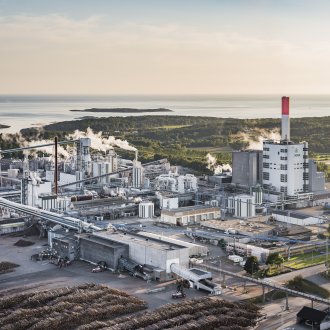
 Södra Pulp Mills. In 2022, Södra Cell Värö (pictured above) generated 822 GWh and Södra Cell Mönsterås generated 721 GWh, while Södra Cell Mörrum accounted for just over 342 GWh.
Södra Pulp Mills. In 2022, Södra Cell Värö (pictured above) generated 822 GWh and Södra Cell Mönsterås generated 721 GWh, while Södra Cell Mörrum accounted for just over 342 GWh.
Feb. 9, 2023 (Press Release) - In 2022, the electricity generated by Södra's own operations amounted to 1,913 GWh, just over 130 percent of the Group's annual electricity needs. That corresponds to surplus electricity of 460 GWh, in a year when electricity prices rose to historically high levels. Södra's surplus electricity was distributed through the local electricity grid and supported the electricity supply in the local communities where Södra operates.
The surplus electricity corresponds to the total annual consumption of domestic electricity for 80,000 small houses, based on figures from the Swedish Energy Agency.* It also corresponds to one million trips through Sweden by electric car.**
"It is gratifying that we are continuing to show strong figures for electricity generation and creating added value from Södra members' forests. The generation plays a key role in our own operational stability, but the surplus electricity also provides additional green electricity for our local communities. This has been particularly important over the past year, which has been dominated by a strained energy situation," said Henrik Brodin, Head of Energy at Södra.
A major share of Södra's total electricity generation comes from Södra Cell's pulp mills. Electricity is mainly generated at the three pulp mills by using the energy in black liquor, which is a by-product of the pulping process. The steam produced from this energy is used to drive the turbines which, in turn, generate electricity. This is an important part of Södra's own energy supply and contribution to the local community.
"Our production process is energy-intensive and resource efficiency is key for us. We have been focused on energy investments in the pulp mills for a long time, and this has now led to a situation where we generate more energy than we use. That creates three major benefits for us: our members get more value for their forest raw material, our production is robust, and we are supporting our local communities with a continuous supply of green electricity. This work will continue and be developed as we move forward," said Henrik Brodin.
In 2022, Södra Cell Värö generated 822 GWh and Södra Cell Mönsterås generated 721 GWh, while Södra Cell Mörrum accounted for just over 342 GWh. The pulp mills also supplied district heating from surplus heat directly to Varberg, Karlshamn and Mönsterås. The sawmills in Kinda and Hamina also supplied district heating. Total district heating supplies amounted to 418 GWh. In addition, Södra delivered nearly 4,000 GWh of solid biofuels to power plants across southern Sweden, where additional electricity and heat was generated.
*According to figures from the Swedish Energy Agency, the average use of domestic electricity per small house is just over 5,700 kWh. Small houses include detached one and two-family houses, terraced houses and semi-detached houses.
**The calculation is based on a car trip of 2,080 km, from the north of Sweden to the south, with a medium-sized electric car with average consumption of 2 kWh per km.
Södra is Sweden's largest forest-owner association, with 52,000 forest owners as its members. Södra is also an international forest industry Group, with operations based on processing its members' forest products, such as softwood and hardwood pulp, and wood products.
SOURCE: Södra
Paper Industry Newsletter
Stay on top of paper industry news
from around the world with
PaperAge's free weekly newsletter.
Delivered every Thursday.
Sign up today!